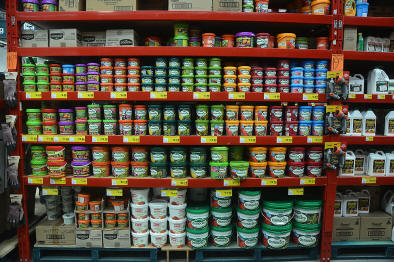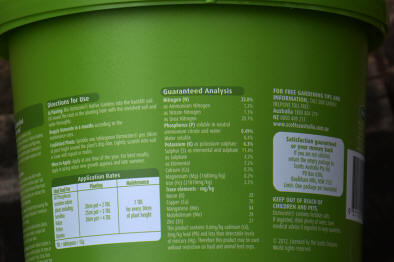Fertilisers are a subject of amazing discussion and hotly held convictions. However, no one has bothered to include the orchids in these conversations ! It it were possible, many of the non-scientifically based theories would be ridiculed to death. Don't be persuaded to pay lots of money for someone's pet fertiliser. You may grow spectacular orchids with it but then again was it that particular fertiliser or you vigilant skills?
Orchids have survived for thousands of years without human assistance. An orchid living on a branch in a remote mountain location could receive minute amounts of nutrient dissolved in water as in drains off leaves and higher up limbs. It could experience an absolute feast if this water washed over a bit of bird or animal poo now and again. These minute hints of nutrition are at great risk of being leached away from the plant as the rain suddenly gets heavier. Keep this scenario in mind when you fertilise your orchids with artificial commercial fertilisers because it holds the secret to feeding your plants. That secret is to apply extremely minute amounts constantly and don't allow any of their chemicals to accumulate.
The left image above shows a fertiliser section in a garden centre. How many university degrees would you need to select the one that can be proven to perform better than the rest in your environment on your particular plants? None. This is all about commercial marketing for profit. There are differences in the various mixtures but they are very small and not very relevant considering the minute quantities that you are going to use to practise the above scenario. Simply pick the cheapest.
Many of the above fertilisers are in the form of small pellets that slowly dissolve over a number of months. Most of the statistics on how long they take to dissolve are very questionable and they don't necessarily dissolve at an even rate. Again, this is not all that important because of the minute amounts you are going to be using. These slow release pellets more closely resemble nature than instant highly soluble fertilisers that risk giving your plants a culture shock like a drug overdose. These all purpose slow release fertilisers are very convenient and time saving for us. It is also reassuring to know that they contain a range of plant chemicals and trace elements whether we need them or not!
The next question is WHEN to do it. Again, given the small amounts that you will be administering it is not mission critical and especially given that you will use slow release pellets that work over many weeks. However, the ideal time to fertilise is when the plants are actively growing and making new roots that can absorb the food and use it to produce new leaves and flowers. This is normally when the plant world gets excited in Spring and again in Autumn.
Add about half a teaspoon of slow release pellets on top of the media in each pot in Spring and again in Autumn if you have time. You could simply throw it around the greenhouse by hand but this quick and lazy method could miss some plants and/or put too much on some others. It can also leave some pellets caught in the leaf junctions or in flowers where it will cause scalding and and ugly but minor damage.
Despite your need to adopt a Spartan approach to fertilising you are still their god and can over-rule nature. Two examples spring to mind. Potassium(K) can help fruiting and flowering of any plant. Therefore you could PLAY with adding miniscule amounts of fertiliser with a higher potassium content since this should encourage flowering and fruiting. The question then is WHEN ! A plant can be compared to an animal pregnancy. The flower is like the animal birth. Nature ensures that the maximum number of off-spring of any living species coincides with good seasons. It is the weeks leading up to the conception point that nutrition is vital. At what point is this in your orchid? It can be 12 months before the flower is produced. The fertiliser proportions of N K an P are normally printed on the container. Compare fertiliser containers and select one with a slightly higher percentage of K.
The second example of when it is tempting to change your fertiliser is when you have orchid seedlings or cuttings. Nitrogen (N) encourages leaf growth and the leaves are what produce plant food through photosynthesis. A slow release fertiliser with an higher nitrogen content could encourage your seedlings or young plants to grow more quickly into a bigger plant more quickly. When the plant has reached the 'teenage' stage you should go back to a normal balanced slow release fertiliser because continuing a high nitrogen rate from this point onwards will tend to continue producing more growth of leaves at the expense of flowers.
The phosphorus(P) component of complete balanced fertilisers fosters healthy roots development which is always important. It is very easy to simply administer it via a balanced slow release commercial fertiliser when you do your 1/2 teaspoon per plant twice a year.
It is very risky to use fertilisers such as blood and bone mixtures, animal manure, etc.. These might be OK for tomatoes and the vegetable garden but they don't exist in our remote jungle. These can kill your orchids within days. Remember, they are a big step from the ancient jungle image that we started with.
There are automatic and computer controlled fertiliser techniques used by large scale commercial orchid growers. They obviously can't afford the time to carefully feed each pot individually.
The left image shows a very cheap simple idea. This is a simple in-line water filter for a normal garden hose. The filter section can be filled with slow release fertiliser pellets. A small wad of porous material, e.g. a bit of crumpled shade cloth, can be inserted in the open end to prevent the pellets falling out. This device can be fitted into the hose line that is used to water the orchids. The pellets need to be replaced every few weeks. It will constantly release a very weak supply of nutrient to all the orchids being watered and comes close to emulating the natural jungle concept that we started with !
The image on the right shows the slow release pellets. If you pay more you might be able to get an even greater range of colours to make them more appertising to your orchids. If your orchids are tough and feral you can buy plain grey pellets !
| < Dividing Plants | Lighting > |



